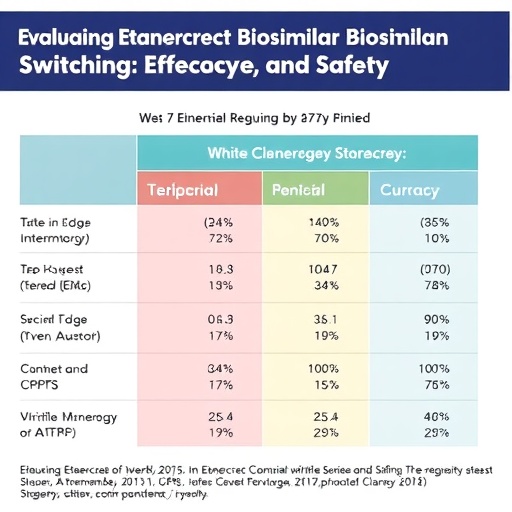In recent years, the advent of biosimilars has revolutionized the landscape of therapeutic options available for chronic inflammatory conditions such as rheumatoid arthritis and psoriasis. Among these biosimilars, etanercept has emerged as a pivotal treatment option. Etanercept is a biologic agent that has been widely utilized since its initial approval, and its biosimilar versions are now available, prompting a significant interest in their efficacy and safety. The implications of switching from originator etanercept to its biosimilars remain a topic of particular interest, as healthcare professionals aim to make informed decisions that uphold patient safety while ensuring treatment accessibility.
A recent narrative literature review conducted by Schmalzing et al. delves into the clinical and real-world evidence surrounding the switching from originator etanercept to biosimilars. This comprehensive examination draws upon a plethora of studies that investigate the outcomes of such switches, providing valuable insights into how these changes impact patient health and treatment effectiveness. Notably, the findings from this research are critical for both clinicians and patients, as they navigate the complexities of biosimilar use in clinical practice.
One of the most notable aspects of the review is the emphasis on efficacy. The review systematically analyzes existing clinical trials that assess the effectiveness of biosimilars when switched from the original etanercept formulation. It highlights a growing body of data that suggests biosimilars can maintain comparable efficacy to the originator drug during and after the switching process. This consistency in efficacy is essential as it assures both healthcare providers and patients that the therapeutic effect they depend on will not significantly diminish with the switch.
Moreover, the safety profile of etanercept biosimilars has gained considerable attention within the review. Switching medications can sometimes lead to concerns regarding adverse effects, and biosimilars are not exempt from such scrutiny. The review meticulously compiles safety data from numerous studies, shedding light on the adverse events associated with biosimilar use. Importantly, it suggests that the safety outcomes observed post-switch are similar to those seen with the originator drug, thus reinforcing the confidence in switching therapies for patients already stable on treatment.
An integral part of the discussion within the literature review involves patient perspectives and real-world evidence. While clinical trials provide a controlled setting to evaluate drug performance, real-world evidence is invaluable as it captures the nuances of patient experiences in diverse healthcare settings. Schmalzing et al. explore how patient-reported outcomes can influence treatment satisfaction and adherence, drawing attention to the need for ongoing dialogue between patients and healthcare professionals regarding any changes in their treatment regimens.
In addition, the narrative review also underscores the economic implications of biosimilar switching. The increasing pressure on healthcare budgets worldwide has created an impetus for the adoption of biosimilars, as these alternatives offer potentially significant cost savings. The authors evaluate the economic studies that analyze the cost-effectiveness of biosimilars in comparison to their reference products, illustrating that switches can alleviate some financial burdens on patients and healthcare systems, without compromising treatment quality.
Engaging with healthcare professionals, the review discusses the critical role of education and communication strategies in facilitating biosimilar acceptance among both providers and patients. Misinformation can lead to hesitancy in adopting biosimilars, so ongoing education and transparency about the efficacy and safety of these alternatives are crucial in fostering a greater understanding of their role in treatment protocols.
Furthermore, the review calls for more robust post-marketing surveillance to continually gather data on biosimilars as they are adopted in real-world settings. Continuous monitoring of long-term outcomes is necessary to ensure that the switching practices are indeed safe and effective as new formulations and therapies become available. This data collection is vital not only for immediate patient safety but also to inform future clinical guidelines and regulatory policies regarding the use of biosimilars.
Another significant theme raised by the authors is the importance of guidelines and policy frameworks that facilitate informed switching practices. National and international organizations play a crucial role in developing consensus statements that enable healthcare providers to make evidence-based decisions regarding biosimilar prescriptions and switches. The authors advocate for the creation of comprehensive frameworks that prioritize patient safety while promoting the use of effective biosimilar treatments.
In conclusion, the narrative literature review by Schmalzing et al. serves as a pivotal contribution to the discourse surrounding etanercept biosimilar switching. By providing a thorough examination of efficacy, safety, patient experiences, economic considerations, and guidelines, it lays the groundwork for further exploration into the implications of these therapeutic transitions. The ongoing evolution of biosimilars presents both an opportunity and a challenge for healthcare providers and patients alike. Therefore, continuous research, patient education, and well-informed policies are essential components to ensure the safe and effective use of biosimilars in clinical practice.
As the body of knowledge surrounding biosimilars continues to expand, the insights from Schmalzing et al. will be invaluable for shaping future research and clinical practice. This evolving landscape reminds us of the critical need for continual vigilance and adaptation in the ever-changing field of medicine, ensuring that patients receive the most effective and safe therapies available.
Subject of Research: Etanercept biosimilars and their switching implications
Article Title: Clinical and Real-World Evidence on Etanercept Biosimilar Switching: A Narrative Literature Review of Efficacy and Safety
Article References:
Schmalzing, M., Askari, A., Girolomoni, G. et al. Clinical and Real-World Evidence on Etanercept Biosimilar Switching: A Narrative Literature Review of Efficacy and Safety.
Adv Ther (2025). https://doi.org/10.1007/s12325-025-03367-5
Image Credits: AI Generated
DOI: https://doi.org/10.1007/s12325-025-03367-5
Keywords: Biosimilars, Etanercept, Switching, Efficacy, Safety, Clinical Trials, Real-World Evidence, Patient Perspectives, Cost-Effectiveness, Healthcare Policies, Treatment Protocols.
Tags: chronic inflammatory conditions treatmentclinical evidence on biosimilarsefficacy of biosimilar switchingEtanercept biosimilarshealthcare professional decision-makingnarrative literature review on etanercept.patient safety in biosimilar usepsoriasis treatment optionsreal-world outcomes of biosimilar switchingrheumatoid arthritis biosimilarssafety of etanercept biosimilarstreatment accessibility with biosimilars





